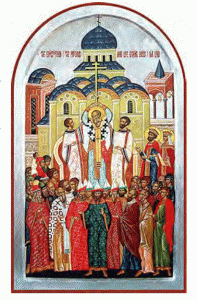 The twelve major feasts of our Church can be divided into various groups. The first is the “Core Group.” This group consists of the Crucifixion of Christ, His Resurrection and Pentecost.
The twelve major feasts of our Church can be divided into various groups. The first is the “Core Group.” This group consists of the Crucifixion of Christ, His Resurrection and Pentecost.
In terms of major feasts, the ante-Nicene Church was characterized by simplicity and a contentment with limiting general festal observance to three feasts, the Crucifixion, the Resurrection, and Pentecost, which apparently had arisen while Christianity was still a sect of Judaism.
The Jewish Pascha or Passover, which begins on the fourteenth day of Nisan, commemorates the salvation of the Chosen People from bondage in Egypt. It is followed by a fifty day penitential period which culminates in the Feast of Weeks, a harvest festival and celebration of the giving of the law to Moses on Sinai. As Jewish sectarians, the very earliest Christians ob served these same feasts both according to Jewish tradition and in commemoration of Christ’s death, the resurrection and the coming of the Holy Spirit. Eventually the Christians broke with Judaism and devised their own method for determining the date of the Pascha so that the Feast of the Resurrection might fall on a Sunday. The Feasts of the Crucifixion and the Resurrection were essentially observed as one feast and correspond to the Jewish Pascha, while Pentecost corresponded to the Feasts of Weeks.
These feasts make up the Core Group not only chronologically (except for the Epiphany none of the others was celebrated as an independent feast for three or more centuries), and calendrically (except for the Dormition and the Transfiguration all of the others are calendrically determined by the Core Group, but also – more importantly – doctrinally. According to Eastern Christian belief, salvation is possible only through the death, resurrection and ascension of Christ who was both God and man, and through the descent of the Holy Spirit. During the first three centuries of Christianity, the Ascension was celebrated either on the Feast of the Resurrection or on Pentecost. Since the Ascension only took on an important character under Cyril of Jerusalem (c. 315-386), it will be considered as part of the Cyrillian Group, the second group of feasts.
The Core Group commemorates Christ’s death and resurrection and, at the same time, reinforces the basic elements of fundamental Christian doctrine of salvation. This Core Group truly celebrates the main action of God to bring us to greater communion with Him. Chronologically and theologically this is our Core Group of feasts.
